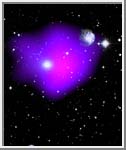|
COMETS EARTH JUPITER KUIPER BELT MARS MERCURY METEORITES NEPTUNE OORT CLOUD PLUTO SATURN SOLAR SYSTEM SPACE SUN URANUS VENUS ORDER PRINTS
PHOTO CATEGORIES SCIENCEVIEWS AMERICAN INDIAN AMPHIBIANS BIRDS BUGS FINE ART FOSSILS THE ISLANDS HISTORICAL PHOTOS MAMMALS OTHER PARKS PLANTS RELIGIOUS REPTILES SCIENCEVIEWS PRINTS
|
Related Document
Download Options
A visible light picture of a three galaxies known as NGC 2300 group, combined with a false-color image (magenta), taken in X-ray light with the ROSAT (an acronym for Roentgen Satellite, a joint project of Germany, the U.S.A., and the U.K.) satellite. The x-ray image, taken on April 25-27, 1992 with ROSAT's Position Sensitive Proportional Counter instrument, shows that the small group of galaxies is immersed in a huge cloud of hot gas, about 1.3 million light-years in diameter. Astronomers estimate that the cloud has a mass equal to 500 billion times that of the Sun, and is at a temperature of about 10 million kelvins (about 18 million degrees Fahrenheit). Although such gaseous material has previously been seen in rich clusters of galaxies, this is the first time such a hot medium has been found in a small group that is typical of most clusters in the universe. The existence of this gaseous envelope allows astronomers to measure the total mass of the system. The surprising result is that the total amount of material in the group is much larger than the sum of the mass of the hot gas and the stars in the galaxies. This means that a substantial amount of invisible "dark matter" envelops the system, keeping the hot gas contained. The NGC 2300 group is located about 150 million light-years from Earth in the direction of the northern circumpolar constellation Cepheus. Credit: John Mulchaey (STScI), David S. Davis (NASA GSFC and Univ. of MD), Dr. Richard F. Mushotzky (NASA GSFC), Dr. David Burstein (ASU). |
